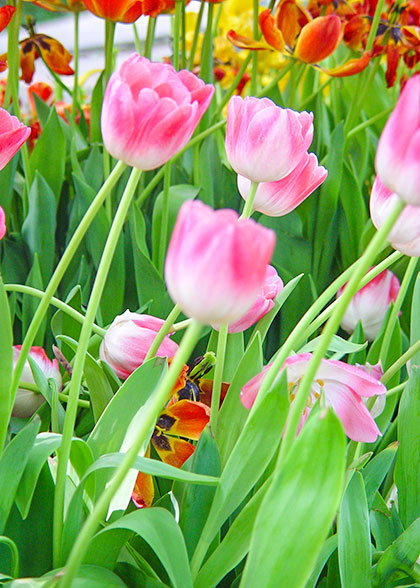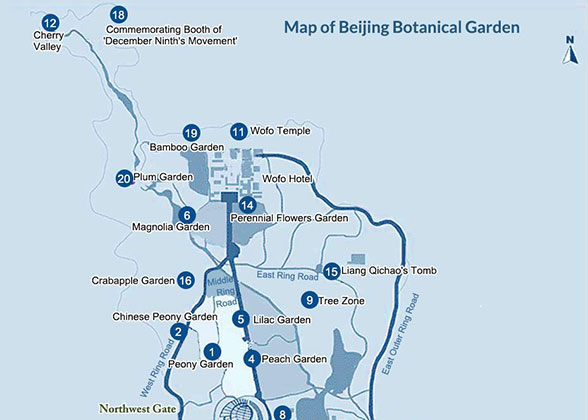Beijing Botanical Garden
China National Botanical Garden, former Beijing Botanical Garden, is located between the Fragrant Hills Park (also called Xiangshan Park) and Jade Spring Hill (known as Yuquan Hill) in Haidian District. It is 15 miles (24 kilometers) far from downtown. In 1956, the project with a planned coverage of 4,000,000 square meters or nearly 1,000 acres was begun. Now, Beijing Botanical Garden has an open area of 500 acres (2,000,000 square meters). It consists of the Plant Exhibition Area, the Scenic Spot and the Historical Resorts, the Scientific Research Area and the Nature Reserve. 10,000 categories of plant with a population of 1.5 million plants are cultivated here, for which this one has been regarded as the biggest in north China so far.
Plant Exhibition Area
The Plant Exhibition Area has four clear divisions. The Theme Gardens have 11 sub-divisions including Lilac Garden, Chinese Rose Garden, Flowering Peach Garden, Peony garden, and so on. The Arboretum Garden has Ginkgoaceae, Coniferales, Mapletrees, Basswood, Magnolia, Berberis, Lysidice and Paulownia.
 |
The Plant Exhibition Area centers on a greenhouse which was open to the public in 2000. With floor space of nearly 2.5 acres (9,800 square meters), it enjoys the reputation of 'the biggest display greenhouse in Asia'. The Greenhouse Exhibition Area is divided into 4 parts: the Tropical Rain Forests Area, the Desert Plants Area, the Garden of Seasons and the Theme Exhibition Rooms. Plants of 3,100 varieties with population of 60,000 thrive in the greenhouse, including Lithops, pencil bush and cymbidiums. It makes the Greenhouse an important base for scientific education and research.
Historical Resorts
In the natural and historical resort, there are the Wofo Temple, the Liang Qichao's Tomb (1873–1929, a Chinese scholar, philosopher, journalist and reformist in the late Qing Dynasty 1616 - 1911), who inspired Chinese with his reform movement), the Memorial of Cao Xueqin (the Author of the literary work 'Story of the Stone'---one of the Four Great classical Chinese novels, The Cherry Valley (one of the gardens in the Beijing countryside), the Commemorating Booth of 'December Ninth's Movement' (a student demonstration in 1935, under the organization of Chinese Communists) and the Sites of Longjiao Temple (an ancient Buddhist temple).
 |
| Map of Beijing Botanical Garden |
How to get to Beijing Botanical Garden
1. Take line 10 to Bagou Station. Then transfer to Western Suburban Line and get off at National Botanical Garden.
2. Take line 4 and get off at Beigongmen Station. Get out from Exit A and transfer to bus 932 or 563, and get off at National Botanical Garden Station.
3. Take line 1 and get off at Pingguoyuan Station. Get out from Exit D and transfer to bus 932 and get off at National Botanical Garden Station.
Take bus 318, 360, 505, 563, 698 or 932 to National Botanical Garden Station. You can see the ticket office after getting off.
Beijing Bus / Subway Search
Ticket Fare & Hours
| Site | Ticket Price |
|---|---|
| Botanical Garden (South & North Garden) | CNY 10 |
| North Garden | CNY5 |
| North Garden+Greenhouse +Wofo Temple | CNY 50 |
| Wofo Temple | CNY 5 |
| Site | Opening Hours | |
|---|---|---|
| Mar. 16 to Nov. 15 | Nov. 16 to Mar. 15 | |
| South Garden | 8:00 - 18:00 Stop enterinng at 17:00 | 8:00 - 17:00 Stop enterinng at 16:30 |
| North Garden | 6:00 - 21:00 Stop enterinng at 20:00 | 6:30 - 19:00 Stop enterinng at 18:00 |
| Wofo Temple, Greenhouse, Bonsai Garden, Cao Xueqin Memorial | 8:00 - 17:30 Stop enterinng at 17:00 | 8:30 - 17:00 Stop enterinng at 16:30 |
1. Children under 6 years old or 1.2 meters (3.9 feet) and the old over 60 enjoy free tickets.
2. Children aged 6-18 enjoy half-price tickets.
3. The best time to visit is from March to June, when many flowers are in blossom.